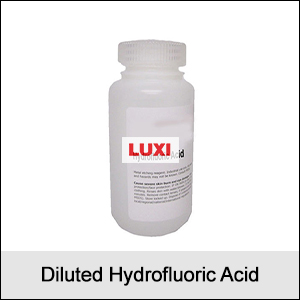Diluted Hydrofluoric Acid
1. Properties of Diluted Hydrofluoric Acid:
- Physical State: A colorless liquid with a sharp, pungent odor. Miscible with water in all proportions.
- Concentration: Commonly available in diluted concentrations, such as 10% to 50% by weight in water. The concentration determines its reactivity and safety measures.
- Reactivity: Reacts with many materials, including glass and metals, by dissolving oxides and silicates. Generates heat when diluted further.
- Toxicity: Highly toxic and corrosive, even at low concentrations. Capable of penetrating skin and tissues, leading to systemic toxicity.
2. Applications of Diluted Hydrofluoric Acid:
- Industrial Uses:
- Etching and Cleaning: Used for etching glass, semiconductors, and metals.
- Oil Refining: Acts as a catalyst in the alkylation process to produce high-octane fuel.
- Pickling: Cleans stainless steel and other metals by removing oxide layers.
- Laboratory Uses:
- Dissolves silicates for chemical analysis.
- Used in geochemistry to prepare samples for study.
- Consumer Products (Rare and Controlled):
- Found in diluted forms in some rust removers or specialty cleaning agents.
- Environmental Applications:
- Used in wastewater treatment to adjust pH or dissolve silica.
3. Safety and Handling of Diluted Hydrofluoric Acid:
- Hazards:
- Corrosive: Can cause severe burns and tissue damage.
- Systemic Toxicity: Fluoride ions can disrupt calcium and magnesium in the body, leading to severe health issues, including cardiac arrest.
- Inhalation Risk: Vapors can damage respiratory tissues.
- Protective Measures:
- Always use in a well-ventilated area or fume hood.
- Wear appropriate personal protective equipment (PPE), including acid-resistant gloves, goggles, and aprons.
- Avoid skin and eye contact at all costs.
- First Aid:
- Skin Contact: Rinse immediately with copious amounts of water and apply calcium gluconate gel to neutralize fluoride ions.
- Eye Contact: Flush with water for at least 15 minutes and seek immediate medical attention.
- Inhalation: Move to fresh air and seek emergency medical care.
4. Storage:
- Store in a tightly closed polyethylene or Teflon container, away from metals and incompatible substances.
- Keep in a cool, well-ventilated area.
5. Common Diluted Concentrations:
- 1-5%: Laboratory use, minimal etching.
- 10-20%: Moderate etching or cleaning applications.
- 40-50%: Industrial use, strong etching and cleaning applications.



